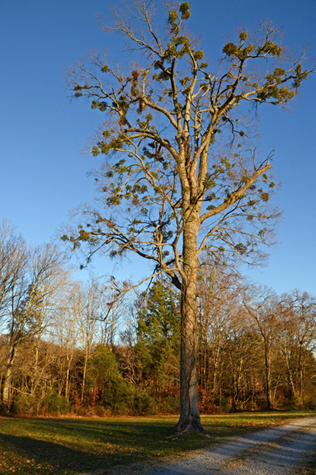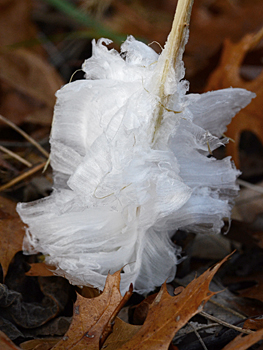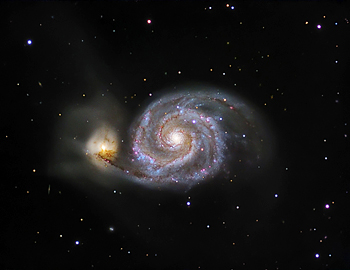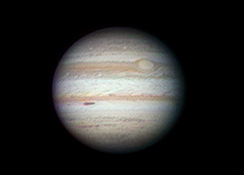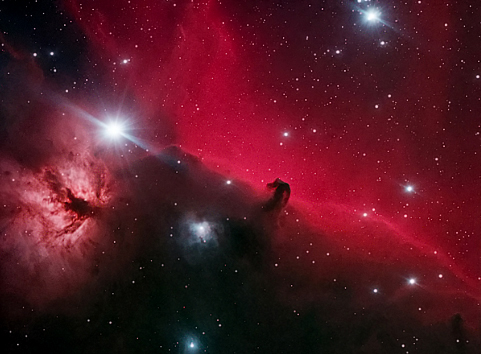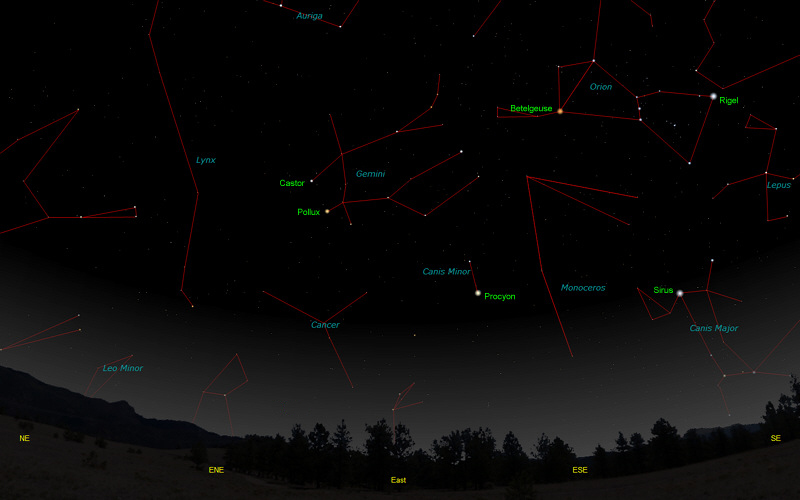The purpose of this feature is to give scout leaders, educators and naturalists an idea of some of the natural events coming up each month. We will try to cover a variety of natural events ranging from sky events to calling periods of amphibians, bird and mammal watching tips, prominent wildflowers and anything else that comes to mind. We will also note prominent constellations appearing over the eastern horizon at mid-evening each month for our area for those who would like to learn the constellations. If you have suggestions for other types of natural information you would like to see added to this calendar, let us know! Note: You can click on the hyperlinks to learn more about some of the featured items. To return to the Calendar, hit the "back" button on your browser, NOT the "back" button on the web page. All charts are available in a "printer friendly" mode, with black stars on a white background. Left clicking on each chart will take you to a printable black and white image. Please note that images on these pages are meant to be displayed at 100%. If your browser zooms into a higher magnification than that, the images may lose quality. Though we link book references to nationwide sources, we encourage you to support your local book store whenever possible. Notes and Images From November 2012
Late fall and early winter bring the opportunity to learn the forms of many tree species. With the leaves down it's easier to see the basic shape of the tree, whether it's opposite or alternately branched, and to see the fineness or coarseness of the branching. Nests of hawks and other birds from the previous nesting season become visible, and many of these will be reused in the nesting season to come. Squirrel's nests stand out starkly. Clumps of Mistletoe can be seen in the crown of many trees. In Tennessee our common Mistletoe is Phoradendron leucarpum. It is semiparasitic, in that it provides some of its own nutrients through photosynthesis and obtains the rest from its host tree. Usually Mistletoe is seen on elms, oaks and poplars. The white berries, though pretty, are poisonous to humans. For a wonderful account of the natural history, myths and lore of Mistletoe see the excellent article by Andrea Shea and David Duhl from the Tennessee Conservationist here.
As the first few hard frosts of the coming winter hit us, we always enjoy seeing Frostweed ice sculptures early each morning. They are another sign of the season. Frostweed, also called White Crownbeard, is a common wildflower in Tennessee that frequents roadsides, streamsides and weedy fields. Its white flowers bloom in August through October. When freezing temperatures arrive, the lower stem splits and water is forced out through the fissures as it freezes and expands, creating beautiful and unique "frost flowers" just above the ground. Part of the beauty of these creations is their transient nature. Often they disappear shortly after the first rays of the sun reach them. For or a brief time, though, these small marvels add a touch of fantasy to the brisk fall mornings.
If you're looking for a perfect gift for a science oriented friend or relative, you might want to consider the SkySafari 3 Pro astronomy app for tablet or cell phone. Needless to say, it's hard to wrap an app, but this application, available for both I-phone and Android operating systems, is nothing short of incredible. Like many of the new generation apps, this program automatically adjusts your sky views whenever you travel. But this program goes far beyond the capabilities of most similar apps. A brief summary taken from the SkySafari site; The program "includes over 15.3 million stars from the Hubble Guide Star catalog, plus 740,000 galaxies down to 18th magnitude, and over 580,000 solar system objects - including every comet and asteroid ever discovered - and a Moon map based on NASA's latest Lunar Reconnaissance Orbiter data. It shows you the sky with sub-arcsecond precision from anywhere on Earth, at any time up to one million years in the past or future." With a computerized "Go-To" telescope, you can control your telescope with your phone! Part of the beauty of the program is how easy it is to tap a star or deep sky object and get a wealth of information, or seamlessly zoom into a telescopic view from a wide field naked eye view. You can get more information, purchase and download Sky Safari Pro here.
Sky Events for December 2012: The winter solstice occurs on December 21st at 5:12am CST, marking the beginning of Winter in the Northern Hemisphere. Owling, Howling, Prowling and the End of the World: It's not often that we can offer up the end of the world as part of our program activities but our owl prowl on December 21st is the exception. We'll be leading a night hike on that date at the Owl's Hill Nature Sanctuary. Included in the program price is a delicious meal and an introduction to the owls of Tennessee. After that we'll take a hike around Owl's Hill by moonlight. As noted above, December 21st is also the date of the winter solstice. We always find the still, quiet winter woods to be a perfect antidote for all of the hectic activity of the holiday season. The much heralded end of the world is also supposed to occur on this date, due to the Mayan Calendar coming to an end. We think the Mayans simply forgot to include a reminder toward the end of the calendar that said, "Time to order a new Mayan Calendar." For a thorough debunking of the craziness, you can go to the NASA web site here. Thanks, NASA, as always, for being a candle in the darkness. Evening Sky:
Jupiter continues to dominate the night sky during December. Now in Taurus, look for it low in the east in the early evening, to the left of the red giant Aldebaran. It will be the brightest star-like object in the eastern sky. To get the best telescopic views, wait until the planet has climbed high above the horizon. Binoculars, if held steady, will show the four Galilean moons when they are not transiting the planet or being eclipsed. Mars appears about 12 degrees above the southwest horizon 45 minutes after sunset on December 1st. Morning Sky: The Geminid Meteor Shower peaks in the early morning hours of December 14th. Conditions are good for the shower this year, with no interfering Moon. Brilliant Venus rises around 4:21am CST on December 1st, and by dawn has climbed fairly high in the eastern sky. Saturn rises about 3:55am on December 1st and can be seen about 5 degrees above Venus in the dawn sky. Saturn's rings have opened up to 19 degrees of tilt. Early in the month, look for Mercury about 8 degrees below Venus. The three planets make a nice grouping in the dawn sky. A good time to see them is about 45 minutes before sunrise. All times noted in the Sky Events are for Franklin, Tennessee and are Central Standard Time.
Constellations: The views below show the sky looking east at 9:30pm CST on December15th. The first view shows the sky with the constellations outlined and names depicted. Star and planet names are in green. Constellation names are in blue. The second view shows the same scene without labels. Look for the bright stars Castor and Pollux in the constellation of Gemini, The Twins. Compare the colors of the bright stars Betelgeuse and Rigel in Orion. Betelgeuse is a red giant and Rigel is a very hot, blue-white supergiant. If you have a telescope, point it to the center of the three "sword" stars below Orion's belt. There you will find the Orion Nebula, M42, one of the most magnificent emission nebulas in the sky. The pink glow of hydrogen alpha light is visible only in very large telescopes and the nebula appears as a small greenish glow in small telescopes. Crouching beneath the feet of Orion, is Lepus, the Hare. Sirius, the brightest star in the sky, shines below Orion. Sirius is in Canis Major, the Great Dog, and for that reason is known as the Dog Star. In the late summer, Sirius rises at the same time as the sun. Because of this, the late summer days are known as the "dog days." The faint constellation Monoceros, the Unicorn, follows Orion over the eastern horizon. Low in the eastern sky below Gemini is Canis Minor, with its bright star Procyon. Procyon means, "before the dog," and refers to the fact that Procyon rises just before the Dog Star, Sirus. Look below Gemini and see if you can spot the faint glow of M44, the "Beehive Cluster." This cluster is located in Cancer, the Crab.
On Learning the Constellations: We advise learning a few constellations each month, and then following them through the seasons. Once you associate a particular constellation coming over the eastern horizon at a certain time of year, you may start thinking about it like an old friend, looking forward to its arrival each season. The stars in the evening scene above, for instance, will always be in the same place relative to the horizon at the same time and date each December. Of course, the planets do move slowly through the constellations, but with practice you will learn to identify them from their appearance. In particular, learn the brightest stars (like Sirius and Procyon in the above scene), for they will guide you to the fainter stars. Once you can locate the more prominent constellations, you can "branch out" to other constellations around them. It may take you a little while to get a sense of scale, to translate what you see on the computer screen or what you see on the page of a book to what you see in the sky. Look for patterns, like the three stars in a line in Orion's belt. The earth's rotation causes the constellations to appear to move across the sky just as the sun and the moon appear to do. If you go outside earlier than the time shown on the charts, the constellations will be lower to the eastern horizon. If you observe later, they will have climbed higher. As each season progresses, the earth's motion around the sun causes the constellations to appear a little farther towards the west each night for any given time of night. If you want to see where the constellations in the above figures will be on January 15th at 9:30pm CST, you can stay up till 11:30pm CST on the December 15th and get a preview. The westward motion of the constellations is equivalent to two hours per month. For instance, if you want to see what stars will be on your eastern horizon on March 15th at 9:30pm CST (3 months later), you would need to get up at 3:30am CST in the morning on December 15th (3 months times 2 hours/month = 6 hours). Recommended: Sky & Telescope's Pocket Star Atlas is beautiful, compact star atlas. It is destined to become a classic, and is a joy to use at the telescope. A good book to learn the constellations is Patterns in the Sky, by Hewitt-White. You may also want to check out at H. A. Rey's classic, The Stars, A New Way to See Them. For skywatching tips, an inexpensive good guide is Secrets of Stargazing, by Becky Ramotowski. A good general reference book on astronomy is the Peterson
Field Guide,
A Field Guide to the Stars and Planets, by Pasachoff. The book retails for around $14.00. Starry Night has several software programs for learning the night sky. Visit the Starry Night web site at www.starrynight.com for details. The Virtual Moon Atlas is a terrific way to learn the surface features of the Moon. And it's free software. You can download the Virtual Moon Atlas here. Cartes du Ciel (described in the monthly notes above) is a great program for finding your way around the sky. It is also free, and can be downloaded here. Apps: We really love the Sky Safari 3 Pro application described above in the Notes and Images from December 2012 section above. For upcoming events, the Sky Week application is quite nice. It is available for both I-phone and Android operating systems.
Amphibians:
December really marks the beginning of the breeding season for our Tennessee frogs and toads. We have had breeding choruses of Upland Chorus Frogs as early as December 4th. Breeding even before Wood Frogs, these irrepressible inhabitants of flooded winter fields and other wet areas will call throughout the cold winter months. Listen for their call, which sounds like someone dragging their thumb across the teeth of a plastic comb, on mild wet winter evenings. Listen also for Southern Leopard Frogs. We hear them throughout the fall. Many other Tennessee frogs and toads can also be seen on mild December nights, but most are silent. Recommended: The Frogs and Toads of North America, Lang Elliott, Houghton Mifflin Co.
Archives (Remember to use the back button on your browser, NOT the back button on the web page!) Natural Calendar November 2012 Natural Calendar September 2012 Natural Calendar February 2012 Natural Calendar December 2011 Natural Calendar November 2011 Natural Calendar September 2011 Natural Calendar February 2011 Natural Calendar December 2010 Natural Calendar November 2010 Natural Calendar September 2010 Natural Calendar February 2010 Natural Calendar December 2009 Natural Calendar November 2009 Natural Calendar September 2009 Natural Calendar February 2009 Natural Calendar December 2008 Natural Calendar November 2008 Natural Calendar September 2008 Natural Calendar February 2008 Natural Calendar December 2007 Natural Calendar November 2007 Natural Calendar September 2007 Natural Calendar February 2007 Natural Calendar December 2006 Natural Calendar November 2006 Natural Calendar September 2006 Natural Calendar February 2006
Natural Calendar
December 2005
Natural Calendar
November 2005
Natural Calendar
September 2005
Natural Calendar
February 2005
Natural Calendar
December 2004
Natural Calendar
November 2004
Natural Calendar
September 2004
Natural Calendar
February 2004
Natural Calendar
December 2003
Natural Calendar
November 2003
Natural Calendar
September 2003 Natural Calendar February 2003 Natural Calendar December 2002 Natural Calendar November 2002 Nature Notes Archives: Nature Notes was a page we published in 2001 and 2002 containing our observations about everything from the northern lights display of November 2001 to frog and salamander egg masses. Night scenes prepared with The Sky Professional from Software Bisque All images and recordings © 2012 Leaps |
|||||||||||||
